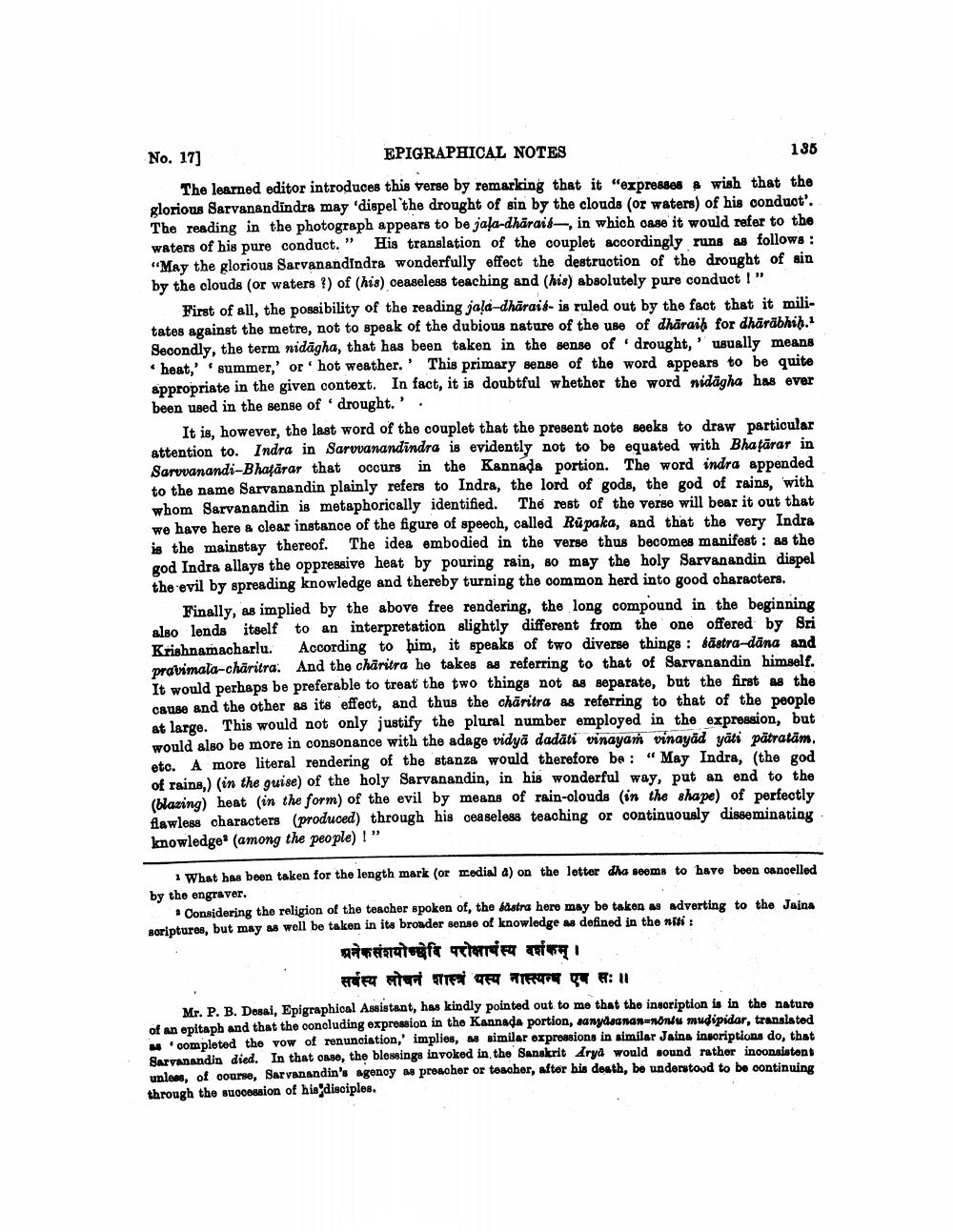________________
No. 17] EPIGRAPHICAL NOTES
136 The learned editor introduces this verse by remarking that it "expresses & wish that the glorious Sarvanandindra may 'dispel the drought of sin by the clouds (or waters) of his conduct'. The reading in the photograph appears to be jala-dharais, in which case it would refer to the waters of his pure conduct." His translation of the couplet accordingly runs as follows: "May the glorious Sarvanandindra wonderfully effect the destruction of the drought of sin by the clouds (or waters ?) of (his) ceaseless teaching and (his) absolutely pure conduct!”
First of all, the possibility of the reading jala-dhārais-is ruled out by the fact that it militates against the metre, not to speak of the dubious nature of the use of dhārail for dhārābhih. Secondly, the term widāgha, that has been taken in the sense of drought,' usually means • heat, gummer,' or hot weather.' This primary sense of the word appears to be quite appropriate in the given context. In fact, it is doubtful whether the word nidagha has ever been used in the sense of drought.' .
It is, however, the last word of the couplet that the present note seeks to draw particular attention to. Indra in Sarvvanandindra is evidently not to be equated with Bhatārar in Sarvvanandi-Bhatarar that occurs in the Kannada portion. The word indra appended to the name Sarvanandin plainly refers to Indra, the lord of gods, the god of rains, with whom Sarvanandin is metaphorically identified. The rest of the verse will bear it out that we have here & clear instance of the figure of speech, called Rūpaka, and that the very Indra is the mainstay thereof. The idea embodied in the verse thus becomes manifest : as the god Indra allays the oppressive heat by pouring rain, so may the holy Sarvanandin dispel the evil by spreading knowledge and thereby turning the common herd into good characters.
Finally, as implied by the above free rendering, the long compound in the beginning also lends itself to an interpretation slightly different from the one offered by Sri Krishnamacharlu. According to him, it speaks of two diverse things : bästra-dāna and pravimala-charitra. And the charitra he takes as referring to that of Sarvanandin himself. It would perhaps be preferable to treat the two things not as separate, but the first as the cause and the other as its effect, and thus the charitra 48 referring to that of the people at large. This would not only justify the plural number employed in the expression, but would also be more in consonance with the adage vidyā dadāti vinayam vinayad yāti pătratām, eto. A more literal rendering of the stanze would therefore be: "May Indra. (the god of rains.) (in the guise) of the holy Sarvanandin, in his wonderful way, put an end to the (blazing) heat in the form of the evil by means of rain-clouds (in the shape) of perfectly flawless characters (produced) through his ceaseless teaching or continuously disseminating knowledge' (among the people) !”
1 What has been taken for the length mark (or redial a) on the letter dha seems to have been cancelled by the engraver.
Considering the religion of the teacher spoken of, the datra here may be taken as adverting to the Jaina soripturse, but may as well be taken in its broader sense of knowledge as defined in the nik :
अनेकसंशयोच्छवि परोक्षार्थस्य वर्शकम्। .. सर्वस्य लोचनं शास्त्रं यस्य नास्स्यन्म एव सः॥ .
M.P. B. Desni. Epigraphical Assistant, has kindly pointed out to me that the inscription is in the nature of an epitaph and that the concluding expression in the Kannada portion, sangdaana n mudipidar, translated
oompleted the vow of renunciation, implies, as similar expressions in similar Jaina inscriptions do, that Sarvanandin died. In that case, the blessings invoked in the Sanskrit Aryd would sound rather inconsistent unless, of course, Barvanandin's agonoy as preacher or teacher, after his death, be understood to be continuing through the succession of his disciples.




